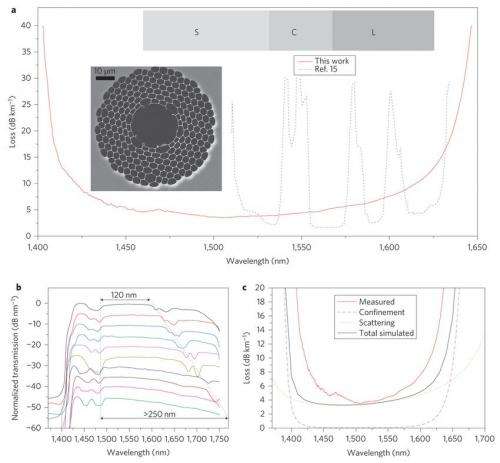March 26, 2013 report
Researchers build fiber cable capable of near light-in-vacuum throughput

(Â鶹ÒùÔº) —A research team at the University of Southampton in England has built a fiber cable that is capable of carrying data at 99.7 percent of the vacuum-speed of light. They have done so, they report in their paper published in the journal Nature Photonics, by constructing a cable with a hollow core and special inner walls that prevent refraction.
Fiber cables technically at least, carry data at the speed of light (299,792,458 meters per second in a vacuum), because the media they carry, is in fact a beam of light. But, in practice, data is carried far slower than that because of latency delays caused by refraction as light moves through the silica glass, which reduces common fiber cable data rate throughput by approximately 31 percent. To get around this problem, researchers have been looking at ways to replace the core of the fibers with air, which suffers far less from refraction. The stumbling point has been how to get the light beams moving through the cables to follow the cable when bends and turns are encountered. That's where this new research comes in—the group has found a new way to build a hollow core fiber cable that allows for bending light as it moves around turns while minimizing loss due to refraction.
The secret is, the team reports, an "ultra-thin photonic-bandgap rim" that provides low data loss, a wide bandwidth and far less latency than standard fiber cables. The result is a cable that in the lab was able to move data, using division multiplexing, at a rate of 73.7 terabits per second, which is approximately 1000 times better than standard fiber cable.
There is a hitch, of course. While data loss is relatively low (3.5 dB/km), it's still too high for use with anything but very short-hop applications, such as the fiber connections inside of supercomputers or perhaps within a data center where the paths the fiber cables take can be run in extremely straight lines. Because of that, the researchers will be working to improve their cable—if they succeed it could one day mean the end of waiting when downloading files, or better yet, to making applications such as real-time ultra high definition 3D transmissions, possible for general use across the Internet.
More information: Towards high-capacity fibre-optic communications at the speed of light in vacuum, Nature Photonics (2013)
Abstract
Wide-bandwidth signal transmission with low latency is emerging as a key requirement in a number of applications, including the development of future exaflop-scale supercomputers, financial algorithmic trading and cloud computing. Optical fibres provide unsurpassed transmission bandwidth, but light propagates 31% slower in a silica glass fibre than in vacuum, thus compromising latency. Air guidance in hollow-core fibres can reduce fibre latency very significantly. However, state-of-the-art technology cannot achieve the combined values of loss, bandwidth and mode-coupling characteristics required for high-capacity data transmission. Here, we report a fundamentally improved hollow-core photonic-bandgap fibre that provides a record combination of low loss (3.5 dB km−1) and wide bandwidth (160 nm), and use it to transmit 37 × 40 Gbit s−1 channels at a 1.54 µs km−1 faster speed than in a conventional fibre. This represents the first experimental demonstration of fibre-based wavelength division multiplexed data transmission at close to (99.7%) the speed of light in vacuum.
Journal information: Nature Photonics
© 2013 Â鶹ÒùÔº

















